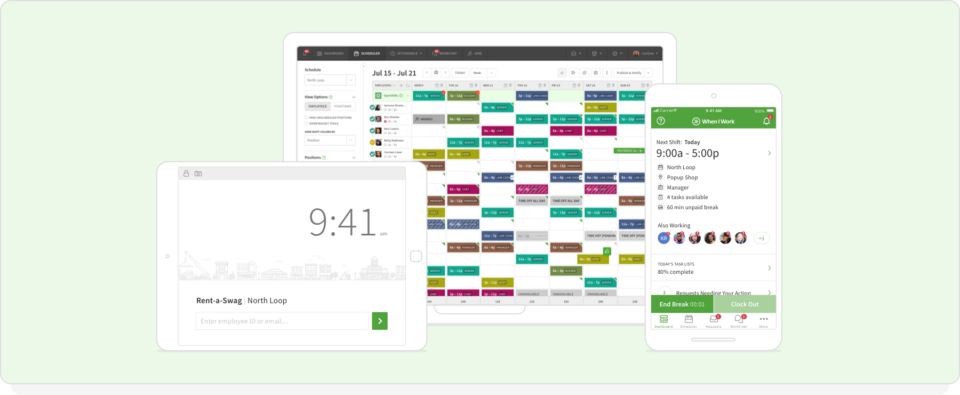Team Building Games For Work Your Team Will Actually Enjoy
Try When I Work for free
Most employees dread “mandatory fun.” But the right team-building games for work don’t have to be awkward, and can be a fun break from the day. And when employees feel connected instead of isolated, their productivity can increase by up to 21%. Whether you’re meeting virtually or in person, the right activities can bring your team together and brighten their day.
Finding the right team bonding game can be tricky because not every team is comfortable with the same types of activities. It’s important to choose games everyone feels safe trying, without putting anyone on the spot.
When you pick simple, low-pressure team-building games for work that respect people’s time and comfort, you get real results:
- Better communication
- Stronger trust
- Higher engagement
- Better teamwork during the actual workday
This list includes fun team-building games for work that fit into almost any workplace, whether you run a retail store, a restaurant, a healthcare team, or a mixed remote group. And if you want team-building that lasts beyond one activity, you can support your team every day with better coverage, fair schedules, and clear communication using employee scheduling software from When I Work.
Key takeaways
- Team building games are a simple way to improve communication, trust, and teamwork at work
- The best team-building games for work are low-pressure, inclusive, and easy to adapt for different teams
- Regular team-building activities can reduce isolation and increase productivity by up to 21%
- Both in-person and virtual team-building games can support employee morale and engagement
- Scheduling and workforce management tools like the When I Work app make it easier to maintain morale between games
Quick list of the best team-building games for work
Here is a quick index of team-building games for work, sorted by goal and group type.
- Icebreaker games for new teams
- In-person team bonding games
- Virtual team bonding games
- Low-prep pen and paper games
- Fast games for staff meetings
- Problem-solving games for teamwork and creativity
Want to save these ideas for later? Download the free ebook version of the Epic List of Great Team Building Games!
Did you know that effective staff scheduling can also improve employee morale? Try When I Work for free and see how better employee engagement can help your business.
Icebreaker team-building games for work

These icebreaker games are great for new hires, mixed groups, and teams that don’t know each other well yet. They help people relax, talk, and open up in a structured way. You can use them before staff meetings, during onboarding, or at any time you want to build stronger team bonding.
What makes you tick
This psychological game for groups helps people share how they work best, what motivates them, and what drains them. It’s a simple way to help coworkers understand each other without putting anyone on the spot.
How to run it
Provide everyone with a list of prompts related to their work preferences. Examples include: “I do my best work when…” or “a stressful day for me looks like…”. Each person answers privately, then shares what they feel comfortable sharing with the group. This game builds empathy and trust without digging into anything too personal.
- Best for: New teams or groups that rely on close collaboration
- Time needed: 20 to 30 minutes
Why it works: It gives every employee space to speak and lets teammates understand each other’s work and communication styles
Truth and lie
Truth and lie is a classic icebreaker and one of the easiest, simple team-building games to run. It works in-person or online, and it helps people open up without pressure.
How to run it
Each person shares one true fact about themselves and one made-up fact. The group guesses which is real. Keep the tone light, fun, and appropriate for the workplace. If you have remote employees, this game works well in group chat or on video calls.
- Best for: Quick staff meeting games and remote team intros
- Time needed: 10 to 15 minutes
- Why it works: It encourages conversation and helps people get comfortable speaking in front of the team
Show and tell
Show and tell is a fun activity for office staff that works just as well with remote teams. It helps people share something meaningful in a low-pressure way.
How to run it
Ask everyone to bring an object from their workspace that represents something about their work style, personality, or interests. Give each person 30 to 60 seconds to explain the item. For remote teams, employees can hold the item up to their camera.
- Best for: Teams that want a creative, low-prep activity
- Time needed: 10 to 20 minutes
- Why it works: It adds a little personality to the workplace and helps spark conversations that build trust
Find the common thread
This icebreaker helps employees discover what they have in common beyond their job titles. It’s one of the best team bonding games for work if you want people to mix outside their usual groups.
How to run it
Split the team into small groups. Ask each group to find one specific thing they all have in common that isn’t obvious, such as a favorite type of food, a shared hobby, or a similar work preference. Once they agree on their “thread,” they come up with a fun group name that matches it. Bring everyone back together and have each group introduce themselves using that name, then briefly act out or demonstrate their stereotype for a minute.
- Best for: New or mixed teams that don’t know each other well
- Time needed: 15 to 20 minutes
- Why it works: It shows how quickly people can find common ground and gently challenges generational stereotypes
Group timeline
Group timeline is one of the most interesting visual icebreaker team-building games. It helps employees see the mix of experience and life stages on the team.
How to run it
Set up a timeline on a whiteboard or wall that covers a relevant range of years. Add a few key company milestones to the line. Give employees sticky notes and ask them to write down a few important moments in their life or career, such as “first job in this industry” or “joined this team.” They place each note on the correct year along the timeline. After everyone adds their notes, walk the group through the timeline and invite volunteers to share one moment.
- Best for: Teams with a mix of tenures or generations
- Time needed: 20 to 25 minutes
- Why it works: It makes experience visible and opens up natural conversation about background and growth
Hello, my name is…
This game uses playful labels to show how attitudes influence the way people interact at work.
How to run it
Write different attitude words on name tags, such as “encourager,” “joker,” “worried,” or “optimistic.” Each employee draws a tag without seeing it and wears it on their back or front. For a set period of time during a meeting or activity, they must respond to others in a way that fits that label. At the end, the group discusses how it felt to “play” that attitude and how labels can shape behavior.
- Why it works: It highlights how language and labels influence how people see themselves and each other
- Best for: Teams exploring communication styles and mindset
- Time needed: 20 to 30 minutes
Penny for your thoughts
This simple icebreaker lets employees share short personal stories without oversharing.
How to run it
Gather coins that all fall within the team’s lifetime. Each person draws a coin at random and looks at the year. They share one meaningful thing that happened to them in that year, at work or in life, that they’re comfortable sharing with the team.
- Why it works: It’s low-pressure, fast, and gives everyone an equal chance to speak
- Best for: Quick intros before staff meetings
- Time needed: 10 to 15 minutes
Stop chasing your team for availability
Icebreakers are fun, but scheduling them shouldn’t be a puzzle. See who’s available and build the perfect shift schedule in minutes.
In-person team bonding games for the workplace

These games work in offices, retail shops, manufacturing facilities, or any environment where the team can move around and interact face-to-face.
Scavenger hunt challenge
A scavenger hunt is a fun team-building game that adds energy to the room and encourages cooperation.
How to run it
Create a short list of items to find or tasks to complete around the workplace. Keep everything safe, simple, and appropriate for your environment. The first team to finish the list wins.
- Best for: Retail teams, office groups, or restaurant staff
- Time needed: 15 to 25 minutes
- Why it works: It encourages teamwork, delegation, and fast decision-making
Human bingo
This is one of the most popular office games for employees because it gets people talking quickly.
How to run it
Create bingo cards with prompts like “has worked here more than three years” or “prefers morning shifts.” Employees walk around the room asking coworkers to sign squares that apply. The first person to complete a row wins.
- Best for: Staff meetings and large groups
- Time needed: 10 to 15 minutes
- Why it works: It encourages quick conversations between employees who don’t normally interact
The line game
The line game is a structured way to help employees bond over shared experiences without making anyone uncomfortable.
How to run it
Place a line on the floor. Read out a series of workplace-focused statements, such as “I prefer hands-on training” or “I like quiet mornings to plan my day.” Employees step forward if the statement applies. Make this optional and keep statements work-related.
- Best for: Teams that need stronger empathy and understanding
- Time needed: 10 to 15 minutes
Why it works: It visually shows how people differ while highlighting shared experiences
The barter puzzle
The barter puzzle is a classic team-building game for work that combines competition and collaboration.
How to run it
Divide employees into equal groups and give each group a different jigsaw puzzle of similar difficulty. Before they start, secretly swap a few pieces between the puzzles so each team is missing some pieces and has extras that belong to other teams. Explain that the goal is to complete their puzzle first. Teams must negotiate, trade, or collaborate with other groups to get the pieces they need.
- Best for: Teams that work across departments or locations
- Time needed: 30 to 45 minutes
- Why it works: It shows that success often depends on other teams and rewards creative collaboration
Common book
Common book is a long-term team-building game that captures your workplace culture over time.
How to run it
Place a blank notebook or scrapbook in a shared area with some simple guidelines, such as “no complaints,” “no swearing,” and “keep it work appropriate.” Leave pens, markers, tape, and glue nearby. Encourage employees to add quotes, sketches, small stories, or photos about team events or inside jokes. When the book is full, start a new one and keep the old volume on a shelf.
- Best for: Teams that share a physical space
- Time needed: Ongoing, five minutes at a time
- Why it works: It creates a living history of the team and gives employees an easy way to contribute to the culture
Geocache adventure
This game works well for off-site days or larger educational campuses, blending scavenger hunts with problem-solving.
How to run it
Hide small containers or clues around your building or outdoor area. Give teams GPS coordinates or simple maps and a list of clues that lead to each spot. At each location, teams find a new hint or small challenge before proceeding to the next one. The first group to complete the route wins.
- Best for: Team off-sites and days when people can move around
- Time needed: 45 to 60 minutes
- Why it works: It encourages navigation, collaboration, and shared wins outside daily tasks
Organizational Jenga
Organizational Jenga turns a familiar game into a lesson about structure and roles.
How to run it
Label Jenga blocks with departments and roles that reflect your team, such as “IT,” “front of house,” or “shift lead.” Divide employees into groups and ask them to build any structure they want using all blocks. Once the build time is over, each group takes turns removing one block at a time, just like standard Jenga, without letting the structure fall.
- Best for: Explaining how different roles support the whole team
- Time needed: 25 to 35 minutes
- Why it works: It visually shows how removing one role or department affects the stability of the whole system
What’s my name?
This is one of those team-building games that uses stereotypes to spark honest discussion.
How to run it
Write names of famous people or broad “types” of people, such as “coach,” “nurse,” or “early bird,” on sticky labels. Place one label on each employee’s back so they cannot see it. Employees move around and ask yes-or-no questions to figure out who they are, while others treat them according to that label. Once someone guesses correctly, they can remove the label and stay to help others.
- Best for: Teams that are ready to talk about bias and assumptions
- Time needed: 20 to 30 minutes
- Why it works: It shows how quickly people lean on stereotypes and how that affects interactions
Watch where you step
Watch where you step is one of the most engaging teamwork games for adults that focuses on trust and communication.
How to run it
Use tape to mark a “maze” or path on the floor. Place “mines” inside the maze using paper with large X marks, and add a few safe squeaky toys. Blindfold a few team members and ask them to walk through the maze from start to finish without stepping on a mine or leaving the path. Teammates who aren’t blindfolded stand outside the maze and guide them using only verbal directions. If someone steps on a mine, they freeze until another blindfolded teammate steps on a squeaky toy.
- Best for: Teams that need stronger trust and clear communication
- Time needed: 20 to 30 minutes
- Why it works: It forces employees to rely on others and give precise, timely instructions
Classify this
Classify this is a team-building game that asks employees to look at familiar objects in new ways.
How to run it
Place 20 to 30 random objects on a table, such as office supplies, kitchen tools, or toys. Divide employees into small groups and ask each group to sort the objects into four categories of their choice, without communicating with other groups. When time is up, each group shares how they classified the items and why.
- Best for: Teams that design processes or solve complex problems
- Time needed: 15 to 20 minutes
- Why it works: It encourages flexible thinking and shows how people see patterns differently
Telephone, on paper
Telephone, on paper, is a drawing-based version of the classic telephone game.
How to run it
Give each employee a sheet of paper and ask them to draw a simple picture without showing anyone. They pass the paper to the right. The next person writes a short description of the drawing at the top, folds the paper to hide the image, and passes it on. The next person draws a picture based only on the description they see. Continue alternating between drawing and describing until the paper returns to its original owner, then reveal the entire chain.
- Best for: Icebreakers before longer meetings
- Time needed: 15 to 20 minutes
- Why it works: It shows how messages change as they move through a group and creates plenty of laughter
Triangulate your place
This energetic game gets people moving and tests memory and awareness.
How to run it
Ask all but one team member to stand in a triangle formation facing inward. Place the remaining person in the center. Everyone quietly notes who they’re standing next to and where they are in the triangle. The person in the middle spins slowly, then stops and calls out, “Go.” The group has a short time to return to their original positions around the triangle based on the new direction.
- Best for: Teams that benefit from physical movement and quick coordination
- Time needed: 10 to 15 minutes
- Why it works: It builds awareness of others, quick thinking, and cooperative problem-solving
Keep your team connected beyond the game. Centralize your team chat and shift updates in one app with When I Work.
Virtual team-building games for remote teams

These virtual icebreakers and online team games help remote and hybrid employees feel connected, energized, and ready to collaborate. They work for any video platform and require minimal prep.
Virtual two truths and a twist
This is one of the simplest virtual icebreakers for new employees because it creates instant engagement.
How to run it
Ask each employee to share two true facts about themselves and one “twist.” The twist can be an exaggerated fact or something believable but untrue. The group guesses which statement is the twist.
- Best for: New hire onboarding and remote team bonding
- Time needed: 5 to 10 minutes
- Why it works: It builds rapport and gives employees a low-pressure way to share something about themselves
Online escape room mini challenge
Escape room puzzles are trending high among psychological games for groups and creative teamwork games, and for good reason. They spark collaboration and problem-solving in a fun online format.
How to run it
Choose a short online escape room or puzzle scenario. Divide employees into small breakout rooms. They must solve clues before time runs out, then regroup to share results.
- Best for: Remote teams that enjoy puzzles
- Time needed: 10 to 20 minutes
- Why it works: Employees practice communication and delegation under time pressure
Screenshot scavenger hunt
This quick activity is one of the best Zoom bonding ideas because it works instantly in any virtual meeting.
How to run it
Create a list of items or prompts such as “something green,” “a favorite mug,” or “a tool you use every day.” Employees race to find each item in their workspace and hold it up to the camera.
- Best for: Teams that need an energy boost during long meetings
- Time needed: 5 to 8 minutes
- Why it works: It gets people moving, laughing, and sharing pieces of their work environment
Collaborative story builder
This interactive activity aligns with creative teamwork games and helps employees practice active listening.
How to run it
Start a story with one sentence. Each employee adds one sentence when it’s their turn. Encourage playful ideas and twists. Keep the final story light and work-friendly.
- Best for: Creative teams and groups that need better communication skills
- Time needed: 10 minutes
- Why it works: It strengthens collaboration, improvisation, and communication
Online team trivia
Trivia consistently ranks as one of the most popular virtual group games because it’s inclusive and easy to customize.
How to run it
Prepare 10 to 15 trivia questions related to work topics, general knowledge, or company history. Employees answer individually or in teams using the chat or a shared Google Sheet.
- Best for: Teams of any size
- Time needed: 10 to 15 minutes
- Why it works: It delivers friendly competition without requiring physical materials
Mad lib mission statement
This game lightens up serious language and helps employees reconnect with your mission.
How to run it
Take your company’s mission statement and remove several key nouns, verbs, and adjectives. Replace them with blanks labeled with the type of word that should go there. Ask employees for words to fill each blank without telling them they are rewriting the mission statement. Read the silly version aloud, then repeat the exercise with more thoughtful words that better reflect the team.
- Best for: Teams that feel disconnected from company language
- Time needed: 20 to 25 minutes
- Why it works: It strips away jargon and helps employees shape a mission statement that feels authentic
What’s on your desk
What’s on your desk is a flexible game that works especially well for remote teams.
How to run it
Ask each employee to choose one item from their desk or workspace. Give them a few minutes to invent a product concept around that object, including a name, slogan, and target customer. Each person has up to two minutes to “pitch” their product to the group.
- Best for: Creative teams and remote meetings
- Time needed: 20 to 30 minutes
- Why it works: It turns everyday objects into prompts for creativity and presentation practice
You get one question
This game reveals what each person values most when evaluating others.
How to run it
Create a few scenarios, such as hiring a new shift supervisor, picking a project lead, or choosing a new vendor. For each scenario, ask employees to write down one question they would ask to decide if someone is the right fit. Collect and read the questions, then discuss what each question reveals about priorities and the decision-making process.
- Best for: Leadership teams and hiring managers
- Time needed: 20 minutes
- Why it works: It surfaces different perspectives on what makes someone trustworthy, capable, or aligned with your values
Active listening
Active listening is one of the most practical and stress-free team-building games for work meetings.
How to run it
Prepare a short, somewhat boring paragraph filled with jargon and a few hidden “real” sentences that contain specific instructions or facts. Read it aloud in a flat voice during a meeting. Afterward, ask employees to write down what they remember, then quiz them on the hidden details. Discuss what helped some people stay engaged and what made others tune out.
- Best for: Teams that struggle with miscommunication
- Time needed: 15 to 20 minutes
- Why it works: It highlights how easy it is to miss important information and opens a discussion on better listening habits
Company concentration
This is a company-themed version of the classic concentration card game.
How to run it
Create pairs of cards that represent company-related images, such as products, locations, or team members. Shuffle and lay them face down on a table or shared virtual board. Teams take turns flipping two cards at a time, trying to find matching pairs. When they flip a card with a person or product, they must say the name or a key fact before moving on.
- Best for: New hires and growing teams
- Time needed: 20 to 25 minutes
- Why it works: It helps employees learn names, products, and internal language in a relaxed way
Company concentration: Debate version
This twist on company concentration focuses on making smart connections instead of finding exact matches.
How to run it
Create cards that show related but not identical concepts, such as two customer personas, two product features, or two common problems. When a team flips two cards, they can earn extra points by explaining how the two items connect. If the group agrees with their explanation, they get the points. If not, they lose a point, and the cards are returned.
Why it works: It trains people to spot relationships between ideas and justify their thinking in a clear way
Best for: Strategy discussions and product or service teams
Time needed: 25 to 30 minutes
Pen and paper team-building games

These low-prep games are perfect for short meetings or quick warm-ups. They require only simple materials, work for any team size, and support problem-solving, communication, and collaboration.
The 30 circles challenge
This creative thinking classic is one of the most popular paper-and-pen activities for work because it’s simple and energizing.
How to run it
Give each employee a sheet of paper with 30 blank circles. Set a timer for 60 seconds. Employees fill in as many circles as possible with drawings that turn each circle into something recognizable. Afterward, teams compare ideas.
- Best for: Creativity warm-ups or brainstorming sessions
- Time needed: 5 minutes
- Why it works: It loosens up mental blocks and encourages rapid idea generation
Back-to-back drawing
This activity consistently appears in simple teamwork games because it improves communication under constraints.
How to run it
Pair employees. One person receives an image or simple shape. They must describe the image without naming it. Their partner tries to draw the image based only on the description.
- Best for: Communication training and team collaboration
- Time needed: 5 to 8 minutes
- Why it works: It highlights clarity, listening, and patience
Riddle relay
This fun group riddle activity builds teamwork and quick thinking.
How to run it
Prepare a list of short riddles or logic puzzles. Divide the team into groups. Each group must solve a riddle to receive the next one. The first group to finish all the riddles wins.
- Best for: Problem-solving teams or between-meeting sessions
- Time needed: 10 minutes
- Why it works: It encourages collaborative thinking and shared decision-making
The name grid challenge
This is a simple activity that strengthens memory and connection in new teams.
How to run it
Create a grid with one square for each employee. Each person writes one interesting fact about themselves in their square. Mix the grid. Teams guess which fact belongs to which employee.
- Best for: New hire integration and team bonding
- Time needed: 5 to 10 minutes
- Why it works: It builds familiarity and strengthens group awareness
Category storm
This fast-paced game often appears in meeting game ideas because it keeps employees alert and competitive without increasing pressure.
How to run it
Choose a category such as “office items,” “customer service phrases,” or “foods that start with B.” Set a timer for 30 seconds. Employees list as many items as possible.
- Best for: Warming up before strategy or planning meetings
- Time needed: 2 to 3 minutes
- Why it works: It energizes the group and encourages quick recall
Want an easier way to manage schedules and keep your team organized? Try the When I Work app free for 14 days.
Short team meeting games

These quick, low-prep games help kick off meetings, boost energy, and get employees collaborating. They work well in both small groups and large team meetings.
One word pulse check
This activity works well for team meeting activities and helps keep your team aligned before diving into the agenda.
How to run it
Ask each employee to describe their current mood or mindset using one word. Capture the words on a whiteboard. Use the themes as a quick insight into team energy.
- Best for: Start of weekly meetings or check-ins
- Time needed: 2 minutes
- Why it works: Fast emotional temperature check that strengthens awareness
The 10-second idea challenge
This game is one of the best (and most enjoyable) meeting game ideas and fun group games in the workplace.
How to run it
Choose a topic such as customer experience, workflow improvement, or removing workplace friction. Each employee has ten seconds to pitch one idea related to that topic.
- Best for: Creative warm-ups and brainstorming
- Time needed: 3 minutes
- Why it works: Rapid thinking reduces overthinking and encourages fresh ideas
Silent lineup
This is one of the simplest team-building games for staff meetings, suitable for use in any industry.
How to run it
Ask employees to line up in order of tenure, birth month, or years in the industry without speaking. The group must communicate nonverbally.
- Best for: Communication training and collaboration
- Time needed: 5 minutes
- Why it works: Strengthens trust and forces creative problem-solving
Two truths and a stretch
A work-friendly spin on a classic icebreaker that aligns with office communication games.
How to run it
Each employee shares two true statements about a recent project and one “stretch” goal they want to achieve next. The team guesses which is the stretch.
- Best for: Weekly team updates or new project kickoffs
- Time needed: 4 minutes
- Why it works: Encourages transparency and keeps everyone aligned on goals
Speed connection
This is one of the classic simple activities for team-building, and it’s perfect if you’re looking for fun, motivational games to play at work.
How to run it
Pair employees. Give each pair a prompt such as “a win this week,” “a recent challenge,” or “one skill to improve.” They have 30 seconds to share before switching partners.
- Best for: Cross-team connection
- Time needed: 4 to 6 minutes
- Why it works: Strengthens engagement and quick relationship building
Make meetings easier by keeping your entire team aligned in one place. Try the When I Work app free for 14 days.
Problem-solving team-building games

These problem-solving activities encourage employees to think creatively, communicate clearly, and collaborate efficiently under pressure. They work well for teams that handle customer issues, tight deadlines, or everyday workplace challenges.
Ideas as building blocks
This activity challenges your team to solve a fictional problem by building on each other’s ideas. Each person writes a short solution on a sheet of paper, then passes it to the left so the next person can add another idea on top of it. The chain continues for several rounds until the group reveals the final stack of solutions.
How to run it
Give the group a fictional problem or creative prompt. Have everyone write one idea, pass their page, and build on what they receive. After several rounds, read all the contributed ideas together and discuss how each person approached the problem.
- Best for: Teams that need stronger brainstorming habits
- Time needed: 10 to 15 minutes
- Why it works: It gives every voice equal weight and stops louder personalities from dominating brainstorming sessions
Use what you have
In this game, teams must solve a challenge using only a limited set of supplies. Each group receives the same materials and must create a device or object that meets the goal you set, such as moving a golf ball from one spot to another without electricity.
How to run it
Divide employees into groups and distribute identical supplies. Present the challenge and set a clear time limit. When time is up, each group presents its creation and explains its approach.
- Best for: Encouraging resourcefulness and quick collaboration
- Time needed: 20 to 30 minutes
- Why it works: Teams learn to use constraints creatively and adapt their plans together
Created economy
Your team builds a mini society from scratch, complete with rules, currency, and roles. As the group interacts, new challenges emerge that they must solve together.
How to run it
Have the team define the basics of their invented society. Let them build rules and structure, then start the simulation. Encourage them to adjust or renegotiate rules as issues arise.
- Best for: Exploring team dynamics and leadership behaviors
- Time needed: 45 minutes to 1 hour
- Why it works: The evolving “society” naturally creates problems that require negotiation, compromise, and group decision-making
This is better than that
Teams analyze sets of similar objects and determine which one best fits a given scenario. None of the items perfectly match the description, so groups must debate and prioritize different qualities.
How to run it
Lay out sets of four related objects and read a scenario that describes the ideal item. Each team orders the items from best to worst fit and explains their reasoning.
- Best for: Helping teams compare choices and justify decisions
- Time needed: 10 to 15 minutes
- Why it works: It encourages thoughtful discussion and reveals how people evaluate options differently
It’s your problem
Employees design a group problem-solving challenge for the rest of the team. Once all ideas are submitted, the group chooses one and completes it together.
How to run it
Give each small group time to design a challenge that requires communication, creativity, and teamwork. Pick one of the suggested activities and run it immediately.
- Best for: Allowing teams to create and solve their own challenges
- Time needed: 30 minutes
- Why it works: It encourages ownership and shows team members they can design solutions, not just receive them
Do the math
Team members receive numbered cards and must form groups whose combined numbers match the values of a list of tasks. Once a card is used, it cannot be reused.
How to run it
Give each person three cards with the same number. Assign values to tasks and set a time limit. To “complete” a task, the group must match its value exactly using their cards.
- Best for: Strategy, negotiation, and quick mental math
- Time needed: 20 to 25 minutes
- Why it works: The game reinforces teamwork while showing how individual strengths contribute to group goals
Problem family tree
Each team member maps a work problem by breaking it into smaller contributing factors, creating a visual “family tree” of causes.
How to run it
Ask everyone to write a work-related problem at the top of a page. Then have them identify two causes, break each cause into two smaller causes, and continue this process until the page is filled.
- Best for: Identifying root causes and improving workflows
- Time needed: 15 minutes
- Why it works: It helps people see patterns and understand how small issues add up to bigger challenges
Paper tower challenge
This is one of the best simple teamwork games for groups that want a quick, creative challenge. It teaches communication under time pressure without feeling competitive in a negative way.
How to run it
Split the team into small groups. Give each group a stack of paper and a timer. Their goal is to build the tallest free-standing paper tower they can before the clock runs out. No tape or extra materials allowed unless you decide to add variations.
- Best for: In-person team bonding games
- Time needed: 10 to 15 minutes
- Why it works: Teams must communicate quickly, make decisions, and adjust their design as they go
Group riddle race
Group riddles are an excellent option for team-building because they’re fun, low prep, and work for almost any team size. This activity encourages quick collaboration and creative problem-solving.
How to run it
Find a list of riddles that are challenging yet workplace-safe. Divide employees into groups or pairs. Read each riddle aloud and let groups submit answers. The first correct answer wins that round.
- Best for: Teams that enjoy puzzles and mental challenges
- Time needed: 10 to 20 minutes
- Why it works: It sparks creativity and gives quieter employees an easy entry point to participate
Same and different
This activity demonstrates how teams can align on big ideas despite having small differences. It’s one of the best games that promotes teamwork without needing any supplies.
How to run it
Put employees into pairs or small groups. Give them two minutes to find five things they have in common and five things that are different. Encourage them to focus on work style preferences, strengths, and challenges instead of personal topics.
- Best for: New teams or groups that need to improve communication
- Time needed: 10 minutes
- Why it works: It highlights shared goals and helps teammates understand different perspectives
Why you should care about employee morale

Employee morale isn’t some vague, “feel-good” metric. When your team is happy and supported, your workplace runs more smoothly. Happy employees give customers better service, show up more consistently, and stay longer.
When you focus on employee morale, you are more likely to see:
- Increased productivity
- Better employee engagement
- Higher job satisfaction
All of that means you can retain your top talent for longer and spend less on constant recruiting and hiring. Team building games are an easy way to get started, but they work best when they’re part of a bigger effort to support your staff every day.
How to improve employee morale
Games are a great place to start, but lasting morale comes from how you treat employees in their day-to-day work. Here are a few high-impact areas to focus on.
Offer competitive and relevant benefits
Pay matters, but the benefits you offer can be the difference between keeping top talent and losing them. Benefits that match your team’s real lives show that you value their contribution. For example, transit passes, meal discounts, or childcare support can make a big difference for hourly employees.
Create a culture of trust and transparency
Employees need to feel safe speaking up when something isn’t working. Encourage feedback, invite suggestions, and follow up when people raise issues. When staff see that their input leads to real changes, they feel more invested in the business.
Schedule your employees fairly and honor their availability
Nothing hurts morale faster than ignoring availability or time-off requests. You can use employee scheduling to show that you respect employees’ time and want to help them balance work and life. When scheduling is fair and predictable, it becomes a source of stability instead of stress.
How workforce management solutions help you create a healthy work environment

Team-building games give you a boost for a day. Workforce management tools help you maintain that energy week after week. The When I Work app may start with employee scheduling, but the benefits for morale go much further.
Employees love When I Work because they’re equipped with:
- 24/7 access to the work schedule so they always know when they’re working
- The ability to submit time-off requests and availability preferences so you can schedule around their lives
- Shift swaps and drops that let staff help manage coverage without creating chaos
- Built-in team messaging so work conversations stay in one place with the schedule
As one customer puts it:
“Our employees love the ease of receiving the schedule and requesting time off or changes to the schedule.” Chelsea Balcomb, Head Trainer, Florida Region.
Team collaboration starts with When I Work
Team building games for work are a powerful way to build trust, but the real test comes during busy shifts, last-minute changes, and everyday challenges. That’s where the right tools make all the difference.
The When I Work app helps you to:
- Create employee schedules faster and keep them accurate
- Give your staff more control over their shifts and availability
- Keep staff communication, shift changes, and time tracking in one place
If you want to support stronger team collaboration with better scheduling and clear communication, explore what you can do with When I Work.
Team-building games FAQs
Still have questions about how to fit these into your schedule or how to handle a team that tends to roll their eyes at mandatory fun? Here are answers to the most frequently asked questions about using team-building games in the workplace.
How do I choose the right team-building activity?
Start by reading the room. If your team is new or introverted, consider playing low-pressure or icebreaker games that don’t require acting or physical contact. For established teams that need to improve workflow, choose problem-solving games that force them to collaborate to win.
What if my team hates team-building?
Resistance often stems from fear of embarrassment or wasting time. To fix this, avoid games that put people on the spot (like improv or singing). Stick to short, 5-minute activities at the start of a meeting. When employees see that the games are respectful of their time and comfort, they’ll be more open to participating.
How often should we play team-building games?
Consistency is more effective than intensity. Instead of one giant annual retreat, try a 5-minute icebreaker at your weekly staff meeting or a monthly 30-minute challenge. Regular, small interactions build trust faster than occasional grand gestures. You can use the When I Work app to schedule these distinct “culture blocks” so everyone knows they’re coming.
Can these games work for hybrid teams?
Yes. Most of the virtual games listed above are compatible with hybrid groups if everyone logs into the meeting software individually. For physical games, have in-person staff present to the camera so remote employees feel included. The key is to ensure remote staff can participate equally, rather than just watching the office team have fun.
Do team-building games actually improve productivity?
Yes. Data shows that connected teams are up to 21% more profitable and productive. Games reduce social friction, making it easier for employees to ask for help, share ideas, and collaborate on actual work projects without hesitation.
Article sources
1. Gallup. Lead Your Remote Team Away from Burnout, Not Toward It. June 15th, 2020
2. CUNY Pressbooks. The Psychology of Escape Rooms. Accessed November 17th, 2025






